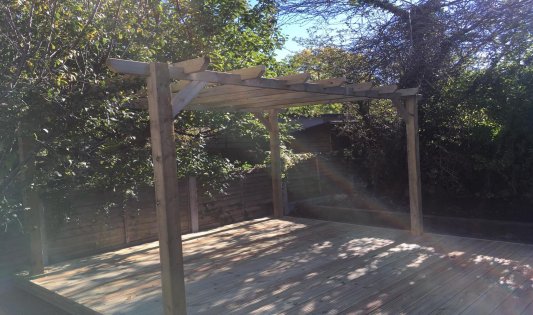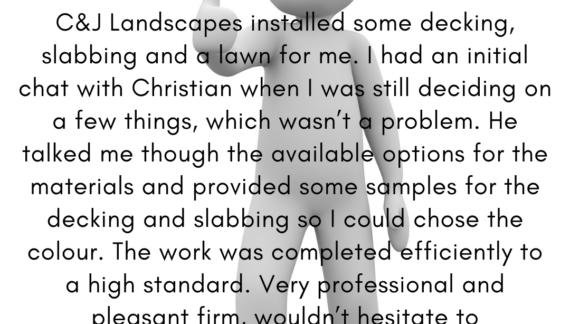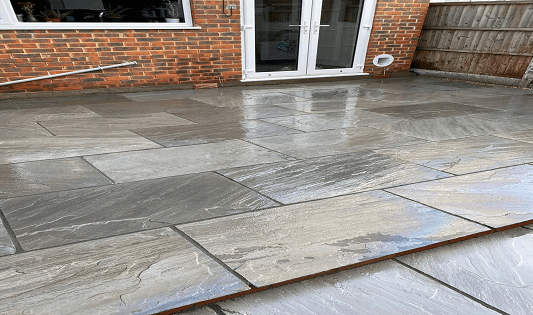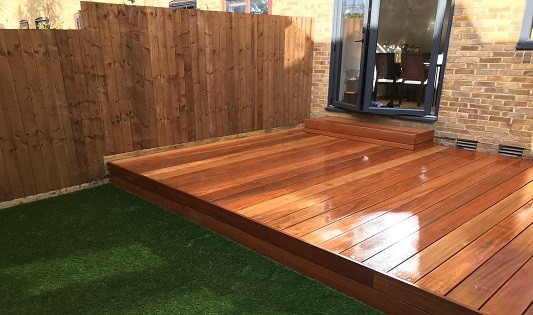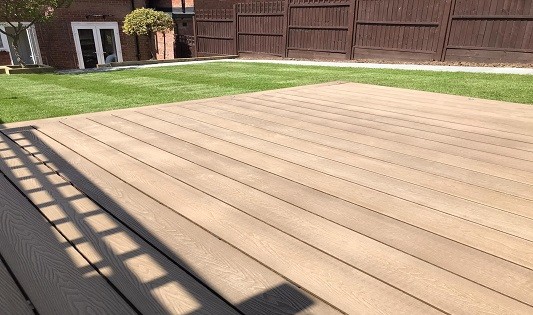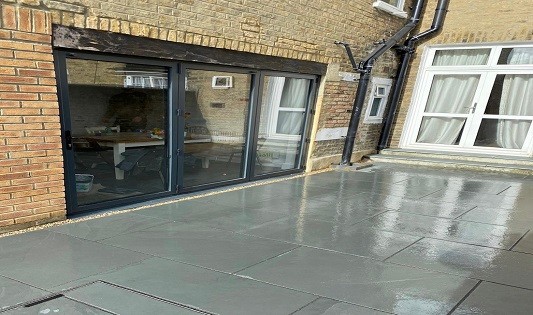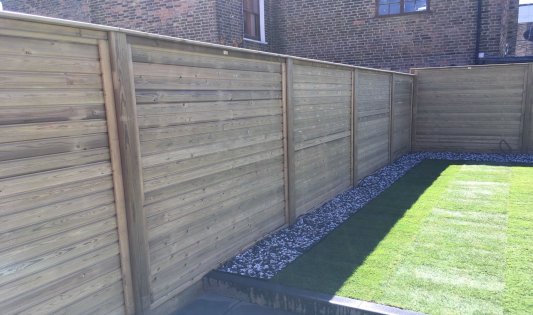Not only does a pergola look great in a garden there are other benefits too making it a good addition. Firstly they really do look great. There are many different styles to choose from and can be built bespoke to your exact requirements. There are a variety of timbers to choose from and many different sizes and styles. Pergolas help to define an outdoor area and also further extend your living space. You can add a pergola across your paving or decking area to define and enhance the area making it a great space for relaxing and entertaining. You can add string lights or hanging lights to brighten your garden at night. We have some string lights hanging on our pergola in our garden at home. You can also train climbing plants to grow up and across the pergola, adding some more greenery to your garden. Popular choices are climbing roses, honeysuckle, clematis and wisteria. A pergola helps to provide more opportunity to spend time in your garden as it makes your garden more useable in all weathers. Providing shade from the sun and also they can be made to shield from rain too. Plus they also give you some extra privacy in your garden if you look to add lattice or screens. If you would like to discuss a pergola project please send an email to office@eastlondonlandscapes.com to arrange a consultation with one of our friendly experienced team.
Garden Design After A House Renovation
Garden Design After A House Renovation. After a house renovation your garden may be left a little worse for wear. It may have been used as a dumping ground during your project or used as a walk through with all the building materials leaving it looking a little tired. Following an extension to your home the garden could need a total redesign to take in the new garden space. Once the house is finished your thoughts turn to your garden to complete your property. You need to think about how you want the space to look. Maybe you would like to have the look that you have inside following out through to your outside space? You could achieve this by bringing the style of your tiles in the kitchen out to your patio with a complimentary paver. You want your garden to blend in with the style of your home. There are many different designs to choose from. A more modern look or you may opt for a more traditional design or a cottage garden. Once you decide on a theme you can start to research online the different ideas. Speak to your landscaper about your aspirations for your garden. What you would like to be included in the design. What is important to you. What will the space be used for. What are your needs for the garden. Are you thinking of an area for relaxing and entertaining. If so a decking area or a patio area could be added. What materials do you like? What colours would suit? Both decking boards and paving slabs come in many different colours and styles. You can also make additions to these with steps, handrails, paving edging etc. Does the lawn need to be redone after the works? If so do you want to re-turf your existing lawn or maybe install an artificial lawn? Artificial lawns are becoming increasingly popular with families, particularly football or basketball fans as they enable them to use the grass area all year round. Do you want to add some raised planters or add some garden beds? You may want to start to grow some of your own vegetables in a raised planter and use them to add colour to your garden with flowers and plants. Think of the garden in sections. You can break up the different areas to create a flow through your garden. An area for entertaining, an area for relaxing and playing. Dividing up your garden into different areas provides a great visual look as you journey between the sections. Is your fencing holding up well? Do you need to replace it or simply fix it. Is now the time to add some horizontal slatted fencing instead to change the look? Or does it simply need a coat of paint of stain to revive it. All of these ideas can be discussed with your landscaper. If you would like to discuss a project with us please send an email to office@eastlondonlandscapes.com or call 020 3633 6413 to arrange a free consultation with one of the team. We cover East London and North London.
How To Choose The Right Paving For Your Garden
How to choose the right paving for your garden. When planning your new patio there are many things you need to take into consideration when choosing the paving slabs for your project. Do you have a specific style of paving in mind? Are you looking for a flat, smooth or riven design? Do you have a colour preference? You need to make sure that the style and colour you choose will compliment your home and is in keeping with the style of your home. Paving slabs come in a variety of sizes. You can choose a uniform look having all pavers the same size, often chosen in a modern garden design. Or a mixed size pack which is often called a “patio pack” and has a selection of different sizes. These packs give you the flexibility to create a random pattern unique to your space. A popular trend this year is for large or oversize pavers in limestone, sandstone or porcelain in light, neutral colours. They create an indoor-outdoor effect as they look more like luxury tiling. These can be laid continuous or a broken-up layout. Budget is an important consideration as paving slabs do vary in price so you need to choose the right paver for your budget. Concrete paving is often the cheapest option. These come in a range of colours and are long-lasting and also recyclable. Natural stone like sandstone, limestone and granite are a very popular choice and are a mid-range option. They are hard-wearing and durable and offer a timeless look to your garden. Also available in a large selection of sizes and colours. If you are looking for a low-maintenance paver then porcelain is a good choice. More expensive than a natural stone it is a very hard-wearing paver, which is non-slip and provides resistance to frost, algae and stains. Are there different levels in your garden? Will you need a retaining wall to accommodate these and if so what materials do you want to use for this part of the project. What would look good against the paving, what material would you like to use, what colour, what size? For finishing touches you can choose to install a paving border to your patio in a different colour to provide a contrast to your paving and to add a visual definition to your patio. If you are planning a new patio and would like to discuss how to choose the right paving for your garden please get in touch to arrange a free consultation and quote. Please send an email to office@eastlondonlandscapes.com. We cover East London and West Essex.
How To Choose Your Decking Colour
Decking is a versatile product and offers many choices for a garden makeover project. You have the choice of different materials. Do you choose traditional wood or composite? Then there are the options of adding steps, handrails, storage solutions, lighting etc but that is a discussion for another day. Finally, the choice of colour. If you choose composite decking it comes in different colours ranging from traditional browns to greys, through to black. If you have wooden decking and decide to paint or stain it you then have the choice of all the paint and stain colours available. When thinking of colour the first thing to consider is your surroundings. Take a good look around. Is the deck going to be built straight out from your property? Or will it be built in a corner of your garden as that is a nice sunny spot where you can sit and relax? What colour would look good against your fencing or walls? Consider what colour looks good against your property. What would work well against the brickwork, window frames and door frames? Do you have a patio down already, you want the colour you choose to compliment this. What style do you want your garden to be. Traditional or modern? The various browns work well in a traditional garden whilst the greys and blacks would suit a more modern look. Think long term too, as your decking will be down for many years. You need to take your time and choose a colour that you will be happy with for a long time. The browns, greys and blacks will work well for a long time but if you decide to paint your wooden decking a bright blue or yellow it is not so likely to last the test of time. Thinking long term too in case you decide to sell your property in the future, it is good to have chosen a colour with staying power that will suit the palette of many. If you would like to discuss a decking project please send an email to office@eastlondonlandscapes.com to arrange a free consultation and quote with one of our friendly, professional team. We cover East London and West Essex.
Latest Client Review East London
Just received this lovely review from a happy client in Leyton, East London. “C&J Landscapes installed some decking, slabbing and a lawn for me. I had an initial chat with Christian when I was still deciding on a few things, which wasn’t a problem. He talked me though the available options for the materials and provided some samples for the decking and slabbing so I could chose the colour. The work was completed efficiently to a high standard. Very professional and pleasant firm, wouldn’t hesitate to recommend.”
Looking After Your Garden Paving
Looking after your garden paving. A patio provides a great entertaining space and is a popular choice and a great addition to your home. As with most things it requires a little maintenance and here are some tips and advice for looking after your garden paving. Sweep your patio area regularly with a stiff broom to keep away any fallen leaves or debris. Remove all furniture and give it a good all over sweep. This easy action helps to prevent seed germination. Weed your patio regularly. Try to remove the weed at the roots to prevent them from growing back. If you come across stubborn weeds or have a fair amount of weeds on your patio you can also use a weedkiller product. Be careful when removing weeds as when pulling up the weeds you can remove some of the sand from the joints and you will need to fill in this gap or the weeds will grow again. Most paving slabs just require a bucket of soap and water to keep clean. If you feel that your patio needs a deeper clean then use a specialised patio cleaner to tackle any stubborn stains. Make sure that you check that the product is suitable for the type of pavers that you have installed. This is really important as you don’t want to cause any damage to the surface of the pavers. If you have a natural stone or concrete paver make sure that any patio cleaner that you use is acid free. Test a small area before use. If you choose to use a jetwash to clean your patio make sure that it is on a low power setting and take care around joint areas as the pressure may break or damage the mortar. Work from a good range and at an angle. It is recommended to wash your patio three to four times a year. Applying a sealant will keep your patio looking its best. Again make sure you use the right product for your pavers. Try to seal your patio every few years.
Treatments For Your Garden Decking
Here we look at treatments for your garden decking. Your decking experiences all of the different seasons in your garden and as with most things needs some maintenance to keep it looking it’s best. One way to do this is to apply a treatment to your deck. If new decking has been installed it is recommended to let it weather naturally for six months before applying any decking treatments. Treatments for your decking can include oiling, staining or giving it a lick of paint. First thing to do is to clear the area, removing any tables or chairs or plant pots, and give the decking a good sweep and a thorough clean. After cleaning allow the wood to dry for at least 24 hours before adding any treatment. Then choose the treatment for your decking. You will need a dry day for this project but avoid very hot weather as it may cause the product to dry too quickly and not fully absorb into the timber. When pouring the oil, paint, or stain out from the container make sure that you do this away from the deck to avoid any splashes. Remember to do a patch test first in a discrete part of the decking to check that you are happy with the finish. You can choose to apply with a brush, roller or paint pads. Rollers or paint pads will enable you to cover an area quicker than using a brush. A brush is good when using paint and for any fiddly areas. Start at the handrail or highest part of the deck to avoid drips falling on finished areas. Then work out from a corner to the entrance of your decking area so that you don’t end up walking on boards that you have just treated. Apply two thin coats rather than one thick one. Leave overnight before applying a second coat of treatment. Oils These are highly recommended as they provide a good level of protection and durability. The oil will penetrate into the wood, replacing any natural oils and resins that are lost over time and waterproofing the timber. Oils are more for protection rather than aesthetics and some decking oils also come with UV protection. You can buy clear decking oils or coloured oils which come in a variety of shades. It is recommended to do this every 6-12 months. Stains Staining a deck provides colour but allow you to still see the natural grain of the wood. It is good to chose a deck stain that is a similar colour to your deck or a shade darker. Staining can be carried out every 1-2 years. Paints Painting your decking gives you a lot of options on colour. Not only providing great colour to your garden but also protecting the wood and giving a fresh new look to your decking. We recommend using a paint that has a UV resistant formula and using a primer first if you are using a light paint colour. For all of the above garden decking treatments allow at least 24 hours before walking on your deck.
Looking After Your Garden Decking
Garden decking is a popular choice and looks great in any garden. It provides a very flexible addition to your home and a great entertaining space. As with most things it requires a little maintenance so please see below some tips and advice on looking after your garden decking. Sweep your decking regularly with a hard broom and hose it down to maintain a good deck. Remove any debris that may have accumulated between the boards using a putty knife. Use a decking cleaner to remove any moss, algae or dirt from the decking. Aim to do this twice a year. Ideally once in the spring and once in the autumn. Remember to cover your plants before starting to protect them from the cleaning solution. Do not use any chlorine based bleach for cleaning as although it will clean the deck it will break down the lignin in the deck timber which holds the wood together. A jet washer can be used to clean the deck but it is really important to not use a heavy duty one. One if around 500 to 600 psi but it certainly needs to be smaller than 1500psi. Important to test the pressure washer on a hidden area first to make sure it doesn’t damage the decking. Use as wide a nozzle as possible to evenly distribute the water pressure. Hold the pressure washer about two foot above the deck and hold the nozzle at an angle. It should be noted that jetwashing may cause damage to the timber fibres. Soda crystals can be used to remove any stubborn stains. Water the deck, sprinkle the crystals, and allow to dry before washing away. Allow the deck to dry for several days before applying any type of finish. After thoroughly cleaning add a decking oil. Even though your deck has been pressure treated in the manufacturing stage it will need to be maintained. Apply the oil with a brush. Good practice is to oil the decking once or twice a year. If your wood starts to look tired and grey it needs oiling. Never drag heavy objects on the surface of a deck to avoid damaging the wood. Move planters, chairs and tables occasionally to avoid discolouring the decking. Trim nearby bushes and trees and don’t let leaves and debris pile up in corners. For newly laid decking it is recommended leaving it to weather naturally for about six months before adding a stain or decking oil. More tips to follow on looking after your garden decking.
Slate Paving
Slate paving is a hardwearing material which seems to improve with age. It is popular in gardens for its anti-slip properties which are due to it being very dense. It is non-porous meaning that is does not allow liquid to easily pass through and it dries quickly (rather handy in the UK with all our rain!) Being a natural stone it is better to use for the environment than a man-made stone. It is a good choice to bring the outdoors in as you can also install indoor slate pavers in your kitchen to provide a seamless flow through. There are options of a flagstone or a paving slab. Flagstones have a more natural and weathered look suited to a traditional garden. Slate pavers suit a more modern garden by providing a crisper look. Slate paving comes in many shapes and sizes and works in both traditional and modern gardens. Different sized riven paving works well in a cottage garden and more standard sizes work well in contemporary spaces. Slate paving is ideal if you are looking for a darker blue or grey colour paver which provides a good background for your plants and flowers. Regarding maintenance it should be given a thorough clean two or three times a year and regular sweeping to keep the area clean. If you would like to discuss a paving project please email office@eastlondonlandscapes.com to arrange a free consultation with one of the team.
What To Consider When Planning A Fencing Project
Here we look at what to consider when planning a fencing project in your garden. There are many things to take into account. Firstly, what are your requirements for your fencing? Are you looking to enhance privacy, trying to try to block out noise, to make sure that your fencing is secure for your pets and children, or you want to create an attractive border around your property? Then you need to consider your budget for the project as the type of fencing you choose can vary in cost and there are many different types of fencing to choose from. One of the first considerations is the type of fence post to install, do you opt for concrete posts and gravel boards or wooden posts and wooden gravel boards. Bear in mind that concrete posts and gravel boards are more costly. Next think about the materials for your project. Do you want softwood or hardwood fencing? Both look great. Hardwood is often darker in hue and chosen for its woodgrain. Softwood is very popular and is more cost effective to use on a project. The softwood fencing that we install is all pressure treated. Composite fencing is growing in popularity as is composite decking and is a very low maintenance option to consider. Then decide on what style you would like for your fencing. Think of the style of your property and how to compliment it. Fencing can be installed vertically or horizontally. Vertical fencing is the more traditional option and very often seen on garden projects. Horizontal fencing suits a modern garden and is very popular with our clients too. Don’t forget the finish of your fencing with accessories. Do you want to add fence caps or a trellis at the top? Is a gate required? Lighting always looks great along a line of fencing and creates a great finish to a garden project. Remember to consider your neighbours and let them know of the upcoming work. The final step is to speak to a professional to discuss your project and get a quote for the work. You need to find a contractor that you feel comfortable working with. If you have any questions or would like to discuss a fencing project, please get in touch. We can arrange a free consultation at your home at a time that is convenient for you. Alternatively you can email across photos of the area to be fenced, together with some measurements, and we can provide an approximate costing by email. We provide landscaping services in East London and West Essex and specialise in paving, decking, fencing, brickwork, driveways, turfing and artificial lawns. Please email office@eastlondonlandscapes.com or call 020 3633 6413.

